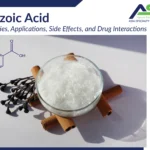Within the realm of organic chemistry, Benzaldehyde stands as a pivotal compound, renowned for its distinctive aroma and versatile applications. This article delves into the multifaceted world of benzaldehyde, tracing its origins, its synthesis pathways, dissecting its molecular structure, and offering practical reminders for its handling and utilization.
Table of Content
ToggleBenzaldehyde: Origin and Types
Benzaldehyde is an aromatic aldehyde, also known as Benzoic Aldehyde, Phenylaldehyde, and Benzenecarboxaldehyde. It is a compound generated by the direct connection of the aldehyde group and phenyl group with the formula C7H6O. Because of its similar fragrance to bitter almond, it was once called bitter almond oil. Benzaldehyde is widely found in the plant kingdom, especially in Rosaceae, mainly in the form of glycosides, such as amygdalin in bitter almonds, stem skins, leaves, or seeds. It naturally exists in bitter almond oil, patchouli oil, cassia oil, and other essential oils.
Read more: https://asi-vn.com/vietnam-cinnamon-cassia-in-north-america-europe/
Benzaldehyde: Synthesis and Formula
With the chemical formula C6H5CHO, Benzaldehyde is a naturally occurring organic compound that gives bitter almonds its flavor and smell. Cassia leaves oil contains about 1 – 3% Benzaldehyde. It is produced by fractional distillation from cassia oil. This natural-origin product appears as a clear colorless to yellow liquid. The Benzaldehyde content of finished products reaches 98%.
Physical properties:
– Appearance: Colorless liquid.
– Odor: It has a distinct almond-like fragrance.
– Melting Point: -26.5 °C (-15.7 °F)
– Boiling Point: 179 °C (354 °F)
– Density: 1.044 g/cm³
How to produce Benzaldehyde in Industry
It can be synthesized through various methods:
Fractional distillation from natural Cassia oil
- Retro-aldol reaction of cinnamaldehyde, which can be obtained naturally through Cassia oil.
- Oxidation of Toluene
- Hydrolysis of Benzal Chloride
Benzaldehyde & Real-life applications
It is used in some important applications, including:
Flavoring and Fragrance Industry
Benzaldehyde is used as a flavoring agent in foods, especially cherry and almond flavors. In addition, with an almond-oil odor, it is commonly used in the formulation of perfumes, and cosmetics to impart a pleasant scent and taste.
Chemical Intermediates
It is used as a precursor to make a variety of chemicals, such as perfumes, dyes, and drugs.
Plastics and Resins
It is used in the production of certain types of plastics and resins. It serves as a starting material for the synthesis of benzyl alcohol, which is further employed in the manufacture of adhesives and coatings.
Pharmaceuticals
It is effective in the synthesis of drugs and other pharmaceutical intermediates. It is utilized in the production of medicines, such as antibiotics and cardiovascular drugs.
Agrochemicals
It has effects on herbicide resistance, plant growth regulation, and amine resistance. The substance can be used in the synthesis of agricultural chemicals.
Benzaldehyde & Cautions
The substance is used as a flavoring and fragrance in food, cosmetics, pharmaceuticals, and soap and is “generally regarded as safe” (GRAS) by the U.S. Food and Drug Administration. It has industrial and agricultural applications, but no environmental or workplace exposure limits have been proposed.
The oral LD50 of Benzaldehyde in rats and mice ranged from 800 to 2850 mg/kg. The intraperitoneal LD50 in white rats was 3265 mg/kg. In short-term oral studies, the no observed adverse effect level (NOAEL) was 400 mg/kg in rats and mice. It has a weak local anesthetic effect and is mildly irritating to the eye and upper respiratory tract. Skin irritation is moderate, and allergic sensitivity may occur in some individuals.
Contact with eyes and skin should be avoided with gloves and protective clothing. Self-contained breathing apparatus should be used in poorly ventilated areas to prevent inhalation exposure.
Conclusion
In summary, this article has unveiled the rich multifaced of benzaldehyde. By delving into its diverse applications and providing essential reminders for safe handling, this guide equips readers with a comprehensive understanding of this foundational compound. This natural-origin product continues to play a vital role in various industries, from fragrance production to pharmaceuticals.
Read more: https://asi-vn.com/all-about-cinnamic-aldehyde/
Asia Specialty Ingredients (ASI), part of Asia Ingredients Group (AIG), specializes in the production and global export of essential oils and natural aromatics. Our range of products is meticulously processed using only the finest natural ingredients sourced from the typical lands of Vietnam, including Cassia, Basil, Star Anise, and more, ensuring good product quality. Contact us for more collaboration opportunity!








